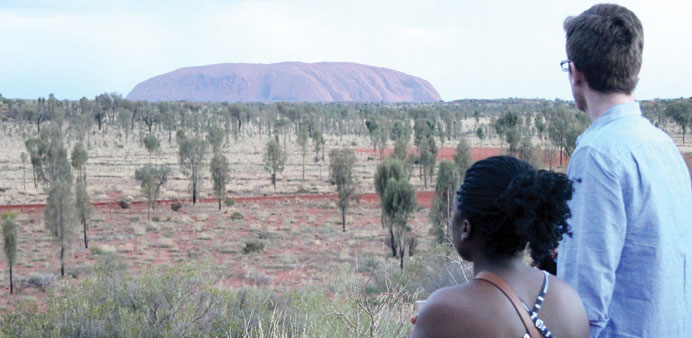|
It is as though that monster rock in the middle of Yulara, Australia were a nugget of gold. |
“You just can’t keep your eyes off it,” American tourist Keith Coleman said of Uluru. “We’ve been here three days and we’ve been looking at it the whole time.”
Coleman, honeymooning with Findy, both from Philadelphia, is not alone in testifying to the pull of the sandstone monolith that used to be called Ayers Rock.
Harold Jorg, who with wife Greta got up early enough to watch as the sun rose over the big red rock, has visited Australia many times but got a particular thrill one early autumn morning in April.
“It was the best experience,” the visitor from Hamburg gushed. “There were two rainbows over the rock. The best experience in Australia.”
Around 300,000 people a year go to the time and expense of seeing Uluru up close. It is at least a three-hour flight from any of the big cities to the settlement at Yulara. The only hotel there is expensive and the only attraction not available anywhere else on the continent is ... the rock.
For some, Uluru can be just a tick on a wish list of things to see and do around the world.
Thomas Brooks, who lives in Panama and was visiting as part of a world tour, was glad he came, but eager to get on to the next place.
“It’s off to Borneo today,” he said. “Don’t ask me. I don’t know where or what we’ll see. I just follow the daily schedule.”
In contrast, Joann Larssen, on that same whirlwind, top-drawer tour, was overjoyed at the two days she spent with her husband within sight of the 347-metre-high sandstone boulder.
“It was all just magical,” she cooed. “There was dinner just for us under the stars. An astronomer told us about the night sky and a man played a didgeridoo, and all around there was lightning, flashes of lightning and bangs of thunder.”
The activities are all about seeing the rock in different light. Get up before the dawn for a bush breakfast as the light comes up. Before dinner, get out to see the sunset from one of the lookouts. Have dinner looking out over the rock as the night closes in.
After Sydney’s Opera House and its harbour bridge, Uluru must be Australia’s most photographed subject.
It does not disappoint, with lots of different shades of red helped along by the monolith’s iron oxide coating.
Business was hit hard by the global financial crisis. There used to be 1,200 staff at work looking after visitors, but there are only 700 now.
“You can’t live here unless you work here,” said guide Ned Thompson. “The people who work here come from all over. We all live together and we really get on.”
The land is owned by the local Ananu people, transferred back to them in 1985, but they are hard to find. Their village, near the rock, is sealed off.
“You wouldn’t want people coming round your place looking in your windows, taking pictures. They’re the same,” Thompson said.
You can fly over the rock by helicopter, drive round it, walk the 10-kilometre trail at the base. There are bicycles to hire, and even camels (though the dromedaries are not allowed in the national park that Uluru stands in).
Climbing the rock is still possible, but officially discouraged and hard to achieve. The path is closed most of the year on a variety of pretexts. It used to be open every day.
Daniel Buxton, 30, gave up his job as a quantity surveyor in England to look after the camels. Tourists ride the beasts on jaunts that offer splendid views of the rock. He gets to look at Uluru every day.
“You get to a point in your life when you wonder what you’re doing,” he said. “And then you just do it. We just booked an airplane ticket and came here.”
The motivation was different for Tim Eade, brought up in an Aboriginal family in the country town of Brewarrina, a 10-hour drive north-west from Sydney.
He tells stories, teaches dancing and puts on cultural performances for the visitors.
“We live our culture here,” he said. “We love it. I got the chance to learn about Aboriginal culture in another place and I took it. These are all my brothers.” —DPA

